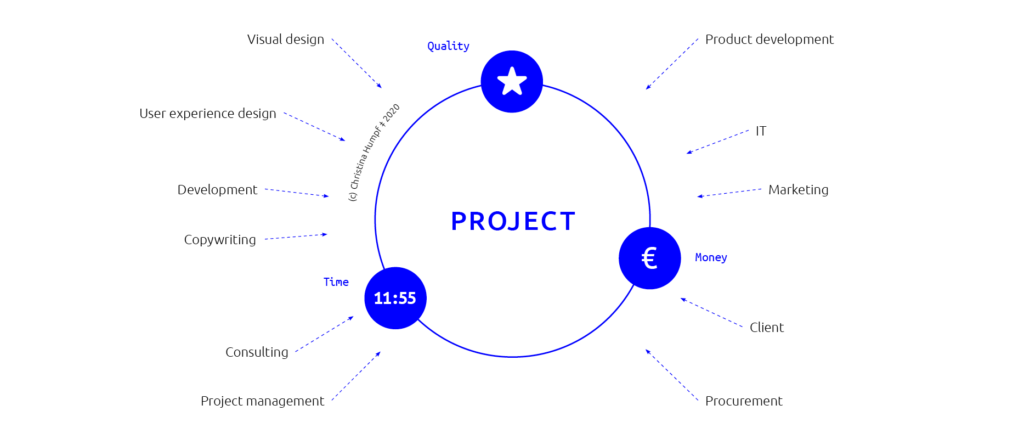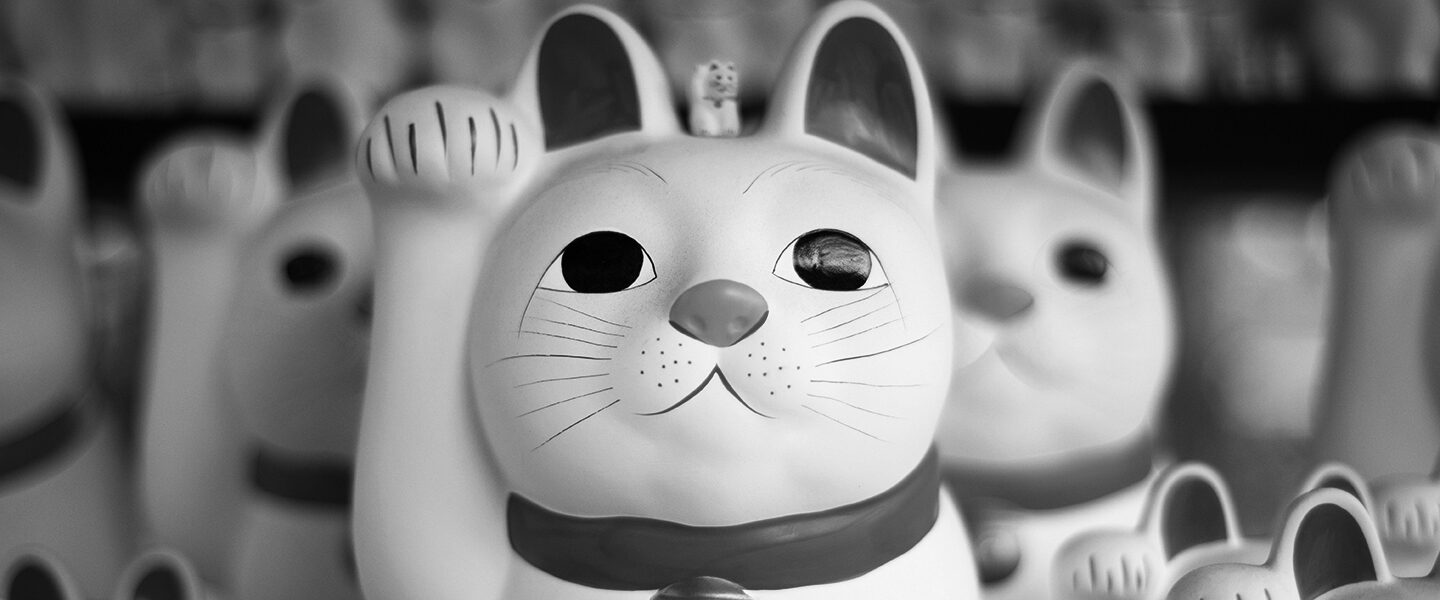This article is also available in German. / Dieser Text ist auch auf Deutsch erschienen. Hier klicken!
This text is part of the “UX Confetti Cannon”, a series of articles about the role of UX, design, our observations within the digital world of work and the different expectations towards the “magic” of user experience design.
The magic of UX
When designing digital products, all “project participants” pursue one goal: to create the best experience(s) for users. Looking into more detail, this promise is embedded in the following framework:
- The success of a “project” is subject to the parameters “quality, time and money”, which are mutually dependent.
- The “participants” are a construct of clients and various areas of competence: consultancy, project management, user experience design, visual design, development and much much more.

For each of these project participants, one of three parameters weighs more heavy than another parameter in daily work routines. The various self-interests often lead to the fact that the overarching goal is lost from sight and ultimately can no longer be achieved.
The big goal of “user experience” merely degenerates to a side note.
Understanding of roles, tasks & assignments
For UX designers, the briefings range between “Can you do a little UX here”, “We need a quick review”, “Just make a concept” or “Design a wireframe out of nothing”. As in project management, visual design or development, the work result practically resonates already within the job title. But not within user experience design.
What used to be “conception” got somewhen fragmented into “user”, “experience” and “design”. But none of these are a finished work results, because:
- “Users” -groups and -interests want to be researched, examined and asked
- “Experiences” need to be designed and should be tested several times
- “Design” does not mean visual or crafted, but usable design; or even a northstar
Of course, some requirements lead into solid work results done by user experience designers, too: interview guidelines, user interviews, usability tests, test reports, wireframes and many more. And with user needs always in mind, UX designers provide relevant advice throughout the entire project (starting with the offer phase).
Taking only “a little bit of UX craft” in some project phases will surely not result in a valid, user-oriented and successful product.
User experience design is more than simply craft, but rather methodology, attitude and participation.
The consequences
Where the know-how and consulting from UX designers would have been necessary in order to create a successful user-centered product, user experience degenerates into a role and thus into a project phase. With regard to the parameters for a successful project, this means the following:
- Time: Since planning and acting during the project was practically done blindly (without user insights), reaching a milestone or the project finish is endangered. It is often even unknown what and how much still has to be done until the finish line.
- Quality: Out of unclear expectations regarding the work results of the project participants, a non-measurable goal (product) has developed. It remains questionable until the end whether users will ultimately accept it, find it credible or simply are able to use it.
- Money: If the project goal is not or just partly achieved, rework is usually necessary; which will lead to more internal and sometimes non-billable costs. Sometimes a follow-up project or subsequent quality assurance is thus questionable or simply impossible. Ka-ching!
- UX designers, whose contribution has been limited from the project start, may not be able to consult, concept and design holistically user-centered (whereby exactly this is how their reputations are measured).
- Money, part 2: Sometimes the relationships between the project participants and project parties are seriously disturbed that further cooperation is mostly unlikely. Follow-up projects might not be offered or ordered anymore.
If we look again at the overall goal for every project member (to create the best experience for the users), satisfied customers are seen as the success- or failure-barometer. In the worst case scenario, the product is not made for the target group. Therefore the work of every project-involved person is unfortunately considered to have failed.

Another point of view
Given: you put a UX designer on a project shortly, intermittenly or late, in the hope that “UX”, “user needs”, “usability” etc. can be ticked off, you should ask yourself: does the clock run backwards? Or do you have infinite resources? If not, then it’s time to bury the faith in the “magic of user experience design”. Because without additional budget or more time, we, UX designers, unfortunately cannot do magic either. UX designers can make the world a little bit better and definitely easier for all project members … But not without the users. We cannot fire a “UX confetti cannon” over a product — and thus achieve a valid user-centricity.
We believe user experience design is an indispensable, integral part of digital product development. Because whenever you want people to interact with your product, you need the expertise of an UX designer throughout the whole project.
To support project participants on their tasks, milestones and targets, UX designers research on leading, decisive factors: “For whom? Why?”. We maintain these parameters in the further course of the project. We can also iteratively test and validate the work results of project members against binding, obligatory targets (a potentially resource-saving process). By following this mode of operation, everyone in the project can iterate, improve and learn during the whole course. Finally, a measurable success can be achieved together. Woohoo!
And next…
“Gestalten heißt, in Fesseln tanzen” (translated “Designing means to dance in shackles”) — the quote from the architect and Bauhaus founder Walter Gropius has rarely been more accurate than within digital product development. Potentially, a certain antagonism is characterizing our work as UX professionals … We love tricky tasks and boundaries. So why is there a dissatisfaction?
It is already in our job title to design for users (but not without asking them). It is our profession to integrate all project participants into this process. And it is up to all of us to foster this discourse. For a common goal. Therefore, we as UX designers would like to cleanse the myth of “User Experience Design”.
Since we do not like destruction, we will continue to write, discuss and advise on this topic. Specifically, it will be about the transformation of tasks for UX designers, organizations and company cultures. We will discuss the profiles and levels of UX designers and similar job titles. And we will write about project processes and project phases. Stay tuned.
We are looking forward to your feedback, your experiences and would like to thank you for your time. All the best and stay healthy.
Disclaimer: Similarities to living people or real events are incidental. This text reflects the opinion of the author and the co-author. The article does not necessarily reflect the opinion of their employers. We are phrasing e.g. “user”, “designer” or “participant” here, so we what to highlight our gender-inclusive intention.
Image Source (Header): Photo by Alain Pham on Unsplash

Hang in there!
Thank you for sharing such valuable information! Your website is truly impressive, and I’m amazed by the level of engagement and passion you have on this topic. It clearly shows how well you understand the subject. I’ve bookmarked this page and will definitely return for more articles. You, my friend, rock! I finally found the information I’ve been searching for everywhere — what a fantastic site!
might send this my project manager before I join my next company ha ha